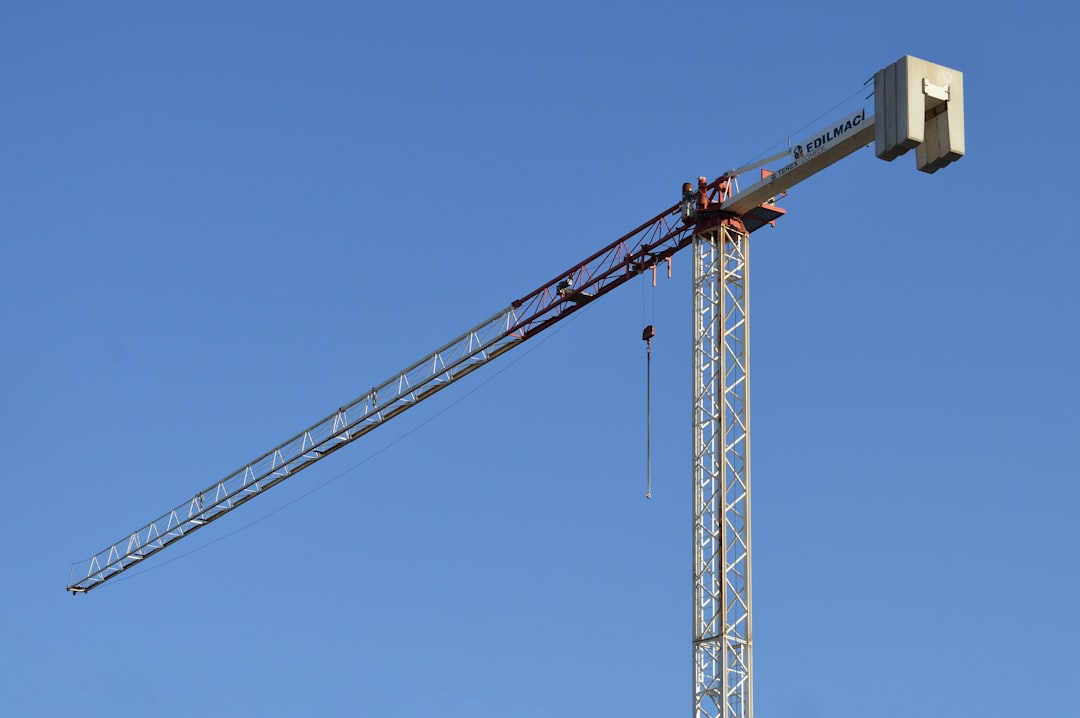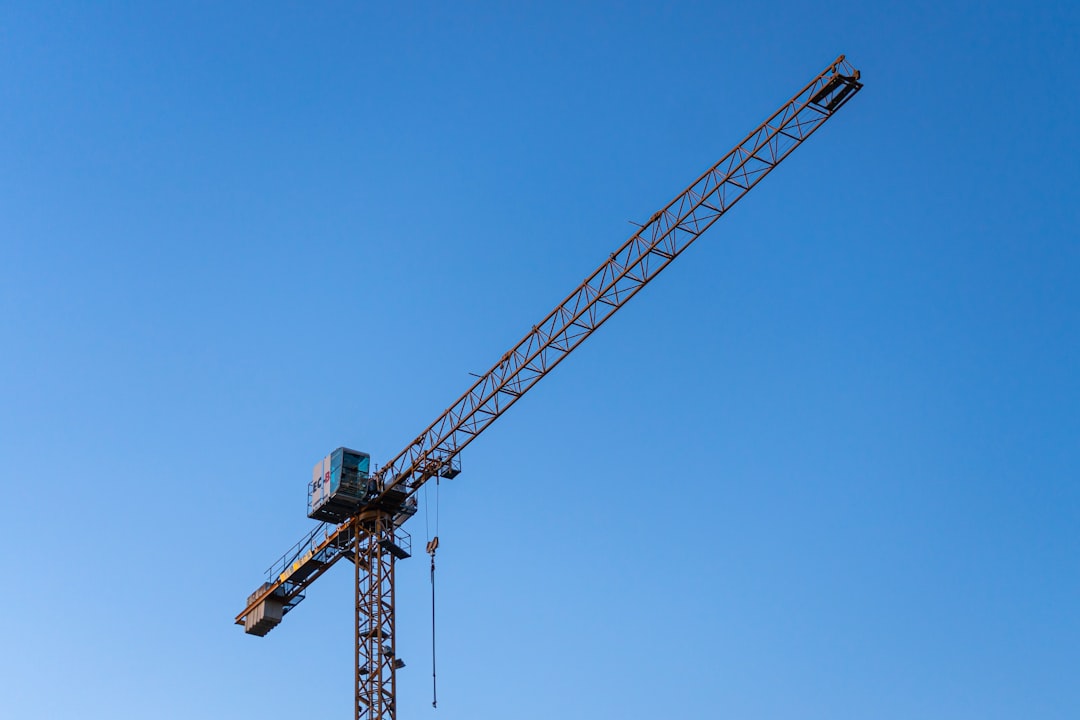

Engage prospects with a scan and streamline customer engagement with FREE QR code marketing tools by Sona – no strings attached!
Create a Free QR CodeFree consultation

No commitment

Engage prospects with a scan and streamline customer engagement with FREE QR code marketing tools by Sona – no strings attached!
Create a Free QR CodeFree consultation

No commitment
The contractor equipment suppliers industry is in the midst of a significant digital transformation. Rising demand for equipment rentals, fleet management, and maintenance means the gaps between physical inventory systems and digital process management feel wider than ever. When suppliers rely on manual check-out forms or paper logs, they risk missing high-value prospects, losing visibility into which companies handle their assets, and leaving both conversion and retention opportunities on the table.
QR codes are now emerging as a practical solution to bridge these divides. Through simple scans, equipment, tools, and inventory areas become trackable digital touchpoints. Suppliers struggling with incomplete or outdated account data, where untracked site visitors or renters never reach the CRM, find that QR code deployments provide up-to-date engagement signals, connecting on-the-ground activity to back-end analytics with the Sona QR product overview. Unlike custom apps or expensive system overhauls, QR codes are cost-effective to implement and accessible for every team member. For broader context on contractor adoption, see industry best practices.
Done right, QR code integration transforms passive equipment lists and physical workflows into actionable data streams. By embedding QR access at every user interaction, from rental and maintenance to compliance, you gain essential visibility into which assets are accessed, by whom, and when. These real-time insights help suppliers close the loop on lost leads, follow up with contractors who show interest but never submit a form, and support more timely upsell or service for engaged accounts. The result is operational excellence and a supply chain that is both smarter and more responsive.

Physical inventory often goes under-tracked, leading to uncertainty around who accessed which equipment and when, or worse, high-value prospects never making it into your customer management platforms. QR codes bridge this gap by linking physical assets to digital oversight using stickers and labels, allowing suppliers to replace brittle analog processes with reliable digital workflows that capture intent and context at the moment of interaction.
The practical playbook begins with identifying friction in your current process. Consider where paper forms, static signage, or verbal instructions create confusion or delays. For example, a printed maintenance log taped to a compressor can be replaced with a QR code that opens a mobile form prefilled with asset ID, model, and last service date via google forms how-to. A laminated product spec sheet on a shelf can become a QR gateway to live inventory, safety videos, and financing options that update without reprinting. Even manual sign-out sheets can be replaced by scans that authenticate users and log check-in and check-out in real time.
As modern QR code tools integrate with CRM and operations platforms, cross-team workflows get simpler. Sales teams receive alerts when high-value accounts scan codes on specialty equipment. Service teams get prioritized tickets with the exact asset, location, and error code. Marketing teams use scan data to build lookalike audiences and retarget based on demonstrated interest. And leadership finally sees a connected view from field engagement to revenue impact.
The step-by-step path is straightforward. Start by mapping your most common offline moments, then replace static or paper elements with QR-powered actions that feed clean data into your systems. Pilot in one branch, instrument outcomes, and iterate on design and placement. Scale the winning patterns across your network using dynamic codes so you can update destinations without reprinting, which preserves budget and improves agility.

Contractor equipment suppliers are familiar with the pain of lost paperwork, missed site calls, and unidentified leads browsing their stock but never converting. With analog processes, there is a persistent lack of insight into real engagement and valuable prospects often slip through the cracks before you can follow up. QR codes function as always-on bridges from the field to your digital systems, capturing intention precisely when interest peaks. For practical contractor-focused tactics, see this contractor marketing guide.
QR codes directly address these challenges by:
These benefits compound as you roll out QR codes across more touchpoints. Start with rentals and maintenance, then extend to warranty registration, parts requests, safety training, and trade show engagement. Each scan builds a richer picture of customer intent and asset usage, which in turn helps you market smarter and service faster.

Managing large inventories often reveals gaps such as equipment checked out to unknown entities, missing maintenance history, or service reps uninformed of urgent requests. Choosing the right QR format for the right scenario addresses these issues quickly and at scale.
Dynamic QR codes are especially powerful for assets in rotation. When a skid steer moves from branch A to branch B, its QR destination can switch to the new branch’s support number and pickup instructions with no reprinting. When you launch a short-term promo or a seasonal maintenance checklist, you can update the landing page centrally rather than replacing labels across hundreds of units. For a construction-focused overview of inventory workflows, see this comprehensive guide.
Match format to context for maximum impact. Use forms for service and checkouts, vCards for quick contact, and web pages for richer content or multi-step actions. Wherever possible, choose dynamic codes so you can iterate without waste and capture analytics for performance optimization.
Growth often escapes teams that lack visibility into how, when, or where contractors interact with their brand. With contacts frequently untracked, post-event follow-ups can miss the mark, and on-site queries never convert because the right person never gets the message. QR codes open growth pathways by converting offline curiosity into measurable digital actions.
By aligning QR deployments to the natural flow of contractors and accounts in your ecosystem, growth stops being guesswork and becomes a consequence of measurable engagement. Use unique codes per channel and placement so you can clearly identify which surfaces and messages drive results, then shift spend toward the winners.

Missed handoffs, incomplete forms, and overlooked intent signals cause suppliers to lose promising pipeline before it ever matures. Real-world QR integrations address this by making each interaction scannable and traceable.
With each use case, modern solutions capture meaningful signals from every scan, retroactively filling the gaps left by traditional analog processes. Over time, you build a robust understanding of asset usage, buyer behavior, and service demand at the account and region levels.
Even in busy construction and equipment environments, many prospects view demos, tap through features, or inspect assets yet never complete a form. That makes follow-up tricky. QR codes solve this by turning physical engagement into structured, taggable events that can power segmented retargeting.
Advanced tools allow you to recognize both known and previously anonymous visitors. When a known account repeatedly scans codes tied to a specific product line, you can route that insight to the account team for outbound follow-up. When anonymous visitors engage with multiple high-intent surfaces, you can increase ad frequency or invite them to a demo day in their region. In short, you shift from broad, generic awareness to precise sequences that reflect real-world interest.
In an industry where touchpoints span in-person events, print signage, field service, and digital portals, tying together scattered marketing efforts is a common pain point. Many suppliers struggle to attribute offline engagement or connect field activity to downstream sales. For a data-driven framework, read Sona’s blog post The Essential Guide to Offline Attribution.
QR codes serve as the offline onramp to your digital engine. With a centralized platform like Sona QR, you can manage all codes from one dashboard, monitor performance by channel and asset, and sync scan data with your CRM and ad platforms. This turns formerly opaque offline activities into a connected, data-rich funnel that improves both marketing efficiency and sales outcomes.
Start by addressing a specific friction point that slows revenue or creates leakage. Examples include digital rental sign-ups at expos, capturing maintenance requests from busy job sites where paper forms go ignored, or turning in-branch browsing into measurable demand. Align the use case with a clear business outcome, such as reduced checkout time, higher service ticket volume, or more demos booked for high-margin equipment.
Define your target audience and context. A code placed on an excavator at a trade show serves a different purpose than a code on a parts bin in the shop. Be explicit about what you want the contractor to do after scanning. For example, Book a walkaround, Request a field service visit, or Compare attachments by project type.
Use static codes for fixed destinations that never need to change, such as a corporate homepage or a universal safety policy. Static codes are simple and durable for long-lived assets that do not require analytics.
Choose dynamic codes when you need editability, tracking, and optimization. Dynamic codes support personalized offers, A/B-tested destinations, and deeper analytics such as scan time, location, and device type. If your goal includes data capture, retargeting, or future flexibility, dynamic is the right choice.
Ensure QR design suits real-world environments. Construction sites have dust, glare, and rough handling. Use high-contrast colors, adequate quiet zones, and a protective laminate or metal plate where needed. Pair every code with a direct call to action and the benefit the scanner will receive. Examples include Scan for live availability, Scan to schedule service, or Scan for parts diagram.
Test scans on multiple devices and in realistic conditions. Check performance on ruggedized phones, under bright lights, and at off-angles that workers commonly use. If codes are on moving equipment, test scan distance and placement so users can scan safely and quickly. Make sure the landing destination is mobile-optimized with minimal fields and fast loads.
Place codes at choke points where untracked handoffs occur. Examples include tool pickup counters, showroom spec displays, entry signage, packing slips, equipment dashboards, and training rooms. Use different codes per placement and branch so you can attribute performance and spot local patterns.
Coordinate rollout with staff training and signage. Explain to teams how QR-enhanced workflows help them serve faster and sell more. Provide a quick script for promoting scans at the counter or on-site. Add small directional arrows or frames around codes to increase visibility and scanning confidence.
Analyze scan volume by channel, asset type, branch, and time of day to identify strengths and gaps. Monitor conversions on the destination pages so you understand where interest drops. Adjust calls to action, creative, and offers based on these signals.
Run controlled experiments. Test alternate landing pages, different CTA language, or varied code placement on the same asset type. Use A/B results to standardize best practices across branches. As you scale, manage and report performance through a centralized platform like Sona QR so marketing, sales, and operations share a consistent view.
In contractor equipment supply, a major pain point is connecting on-site engagement with actual business outcomes. Far too many field interactions never make it into lead tracking or revenue attribution. Without a complete picture, teams struggle to prioritize accounts, demonstrate ROI, or optimize spends across channels. For measurement frameworks, see Sona’s blog post The Essential Guide to Offline Attribution.
Modern QR code management platforms solve this by turning scans into structured events tied to outcomes. You can track every scan’s device, location, and context, surface new leads or high-interest companies that would otherwise remain anonymous, and trigger next steps that move buyers forward. When these signals sync with your CRM and asset management systems, follow-up becomes both timely and relevant.
With Sona QR and Sona.com, you can centralize every step of this process. Sona QR captures real-world engagement such as time, device, location, and campaign source. It measures engagement by channel and context, and it supports real-time optimization. Sona QR also syncs with your CRM to automatically enrich leads and contacts using scan activity. Sona.com then connects scans to pipeline and revenue using buyer journey analytics. It links QR scans with website visits, ad clicks, email engagement, and CRM activity so you get an end-to-end view from first touch to purchase readiness. For modeling approaches, read Sona’s blog post Single vs Multi-Touch Attribution Models.
The result is a closed feedback loop where every QR code fuels smarter decisions. Marketing sees which placements work. Sales gets timely alerts on high-intent accounts. Service prioritizes tickets based on urgency and impact. Leadership measures return on investment with confidence and shifts resources toward strategies that clearly drive revenue.
Creative deployments accelerate adoption. Add repair-scheduling codes to maintenance stickers inside engine compartments. Place QR-enabled directional signs at job sites that route to safety updates and incident reporting. Embed QR codes in delivery crates that open unboxing videos and torque specifications for assembly, reducing setup time and support calls.

These examples highlight a common pattern. By turning passive or untracked moments into scannable interactions, suppliers capture intent and context that previously evaporated. Over time, this data improves forecasting, informs merchandising, and guides staffing and branch expansion.
Today’s contractor equipment suppliers face a market where every scan, page visit, or asset lookup can either create an opportunity or leave hidden value untapped. By integrating QR codes across key workflows, suppliers can bridge analog gaps, turn once-anonymous visits into actionable insights, and connect field activity to business intelligence systems in real time.
With these capabilities, it becomes possible to surface high-intent companies that never submit forms, nurture prospects lost in manual checkouts, and prioritize follow-ups with accounts showing strong engagement signals. QR codes, thoughtfully deployed, are no longer just a convenience; they are a strategic lever for smarter asset management, conversion, and revenue growth.
Adopting QR strategies rooted in real operational challenges unlocks new ways to accelerate project cycles, win more business, and deliver on the efficiency that modern contractor equipment buyers demand. If you want to get started quickly, Start creating QR codes for free. You can manage destinations, measure performance, and sync scans to your CRM. As your programs mature, use Sona.com for attribution and buyer journey analytics so you can connect scans to pipeline and revenue with confidence.
QR codes have transformed contractor equipment suppliers from simple inventory handlers into dynamic, customer-focused service providers. By enabling instant access to detailed equipment information, maintenance history, and usage instructions, QR codes streamline operations and elevate customer experiences. Imagine your clients effortlessly scanning a code to verify equipment specs or request support, turning every interaction into an opportunity to build trust and secure repeat business.
With Sona QR, you can create dynamic, trackable QR codes in seconds that update instantly without the need to reprint labels. This means you can monitor which equipment details or offers engage customers most, optimize your service delivery, and connect every scan directly to measurable outcomes like faster rentals or increased sales. No more guesswork—just actionable insights that drive growth.
Start for free with Sona QR today and transform how you connect, serve, and grow in the contractor equipment supply industry.
Best practices include deploying QR codes at every high-value touchpoint such as tools and vehicles, designing codes with scan-first intent, integrating QR scan data with CRM and asset management systems, defining clear success metrics, and piloting deployments before scaling across branches.
QR codes link physical equipment and tools to digital workflows, enabling real-time tracking of who accessed assets and when, reducing manual errors, improving maintenance scheduling, and providing actionable data streams that improve visibility and operational efficiency.
Benefits include bridging offline and online processes, increasing speed and accuracy of check-outs and maintenance requests, centralizing updates and compliance, providing analytics and visibility into asset usage, reducing operational costs, and enhancing customer engagement and retention.
Reliable contractor equipment suppliers adopting QR code technology can be found through industry platforms like Sona QR and related digital transformation resources that showcase suppliers integrating QR codes for smarter asset and customer management.
Construction companies use QR codes integrated with CRM and operations platforms to digitize workflows, track equipment usage in real time, automate maintenance and service requests, improve customer follow-up, and generate data-driven insights that optimize marketing, sales, and service processes.
Use Sona QR's trackable codes to improve customer acquisition and engagement today.
Create Your FREE Trackable QR Code in SecondsJoin results-focused teams combining Sona Platform automation with advanced Google Ads strategies to scale lead generation

Connect your existing CRM

Free Account Enrichment

No setup fees
No commitment required

Free consultation

Get a custom Google Ads roadmap for your business






Launch campaigns that generate qualified leads in 30 days or less.
